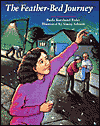Holocaust Education
The Feather-Bed Journey
The Feather-Bed Journey by Paula Kurzband Feder, illustrated by Stacey Schuett. Albert Whitman & Co. : Illinois, 1995.
Brief Overview:
The story is that of a young Jewish girl and her family in Poland during World War II. It is a composite of the stories that were told to the author as a child. Through this tale, two grandchildren, Rachel and Lewis learn the significance of the "Feather-bed pillow" from their grandmother. This book introduces children to both Jewish and Gentile people that risked their lives to help the Jews in danger. The concept of the Displaced Persons Camp is also introduced.
Suggested activities:
1. An excellent website with oral testimonies of 5 Polish Jews can be found at www.tulane.edu/~so-inst/laholsur.html Break up class into five groups, assign each group to read the oral testimony of one of the survivors. The task of each group is: (1) to locate the city of birth of their survivor and place it on a large map of Poland (2) read the testimony and write a summary of the person, including life before Hitlers rise to power, during the Holocaust, and after. (3) Compare and contrast life of the survivor with that of the character in the book.
2. Have students write a letter to Mr. Witkowski from the Rachel and Lewis, the grandchildren in the novel. This letter should express their gratitude to him and should include a short story about what happened to their grandmother after the War.
3. A comprehensive bibliography of Holocaust rescuers, entitled "Whoever Saves a Single Life..." is at
sorrel.humboldt.edu/~rescuers
Other excellent websites on Holocaust heroes can be found at:
fcit.coedu.usf.edu/holocaust/people/rescuer.htm
www.holocaust-heroes.com/index.htm
Have students select any Righteous Gentile, read what he/she did and have each make a quilt square to honor this person or group of people. The square can have a poem, symbol, picture etc. on it with the persons name. The final product is a quilt - The Remnants of the Righteous.
4. Students are extremely curious about where the Jews migrated to after the war. To continue a study of the Displaced Jews in Europe from 1945-1951, an excellent source is
geography.about.com/science/geography/library/weekly/aa051898b.htm
After reading the article, click on charts. Have children visually represent information in the chart on both a world map and in the form of a graph (bar or pie chart). This helps the students visualize where the Jews who were migrating came from and where their destinations were. Using a program such as Excel will be good for such an activity. To continue this activity in math classes, the numbers can be converted into percentages.
